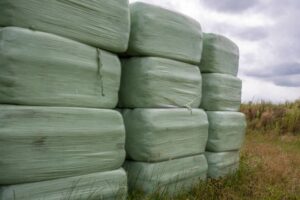Ensure you use the right silage plastic wrap film for your bales, as this can help prevent spoilage and mess. It also helps to keep out oxygen, which leads to premium silage.
Look for a silage wrap film that is made from metallocene polyethylene. This type of film has better mechanical properties and cling values than conventional LDPE. For quality silage wrap film, click here.
Durability
 A quality silage wrap film offers great moisture control and excellent damage resistance, allowing you to preserve the nutritional value of your crops. It also helps to prevent unwanted fermentation processes and extends the life of your bales. This results in less waste and a lower cost for you.
A quality silage wrap film offers great moisture control and excellent damage resistance, allowing you to preserve the nutritional value of your crops. It also helps to prevent unwanted fermentation processes and extends the life of your bales. This results in less waste and a lower cost for you.
The cling layer of the MV-LDPE or LLDPE film is made with PIB liquid, which makes the surface rather sticky and the layers well joined. This provides excellent adhesion to the bales, and the film is abrasion-resistant and puncture-proof. It runs well on all types of wrappers, including 3D wrappers and square bale wrappers.
The 5-layer co-extrusion blown film technology offers flexibility, allowing you to create a unique formula for each layer. This results in superior mechanical properties, even better than the 11-layer cast film. This high-quality silage film is characterised by low oxygen permeability, high tensile strength and excellent adhesion with the bales. It is ideal for storing silage, feed mixes, hay and maise.
Easy storage
Silage wrap film is used to package and protect fodder for winter storage. The wrap keeps the forage from evaporating and promotes controlled anaerobic fermentation, which raises the nutritional content of the grass. This allows for more extended storage and a more stable supply for herds. For quality silage wrap film, click here.
Choosing the proper silage wrap film is crucial. It must be puncture-resistant and have a high tensile strength. It also needs to be able to resist water and UV radiation. Additionally, it should be flexible and easy to use.
The best silage wrap films are made from a special co-extrusion blown film and have multiple layers. This enables the wrap to withstand the rigours of today’s complex bale wrapping machines. These features ensure that the wrap is durable, easy to use and fits perfectly on the bales. This allows for the highest level of forage preservation and prevents oxygen from entering the bale. For the best results, the wrap should be placed on the bales as soon as possible after harvesting.
Easy to sell
Silage wrap is an easy-to-sell agricultural product that helps farmers and ranchers provide animal feed for winter. The film prevents the forage from oxidation and facilitates controlled anaerobic fermentation to preserve the nutrients and improve the tastefulness of the grass for cattle and sheep. This makes it easier to store and transport the forage, which can help reduce the risk of spoilage.
Designed for baling excellence, this plastic film is highly puncture-resistant and offers a high air permeability rating to minimise unwanted infiltration. The high strength and quality of this product make it a top choice for many producers worldwide.
Made in Europe, Venuspower XL is co-extruded with seven-layer film technology to offer superior thickness consistency and piercing resistance. This premium sleeve is UV stabilised to suit Australian conditions and comes in 1650m rolls to cover more bales per wrap, reducing machine downtime, and the number of machine stops. For quality silage wrap film, click here.
Environmentally friendly
Silage wrap film is a vital tool in modern agriculture. It helps preserve the quality of forage and reduces feed waste, which saves both money and resources. It also prevents liquid penetration into the ground, which reduces transportation costs and environmental impact. In addition, it is easy to store and sell.
In order to ensure the best results, farmers need a strong and durable silage stretch film. It must have a high tensile strength, which is measured by the amount of stress that the material can withstand before stretching and breaking. It should also have a low permeability, which prevents oxygen and moisture from entering the silage bales.
In addition to these qualities, the film should have excellent low-temperature resistance and a long storage period.